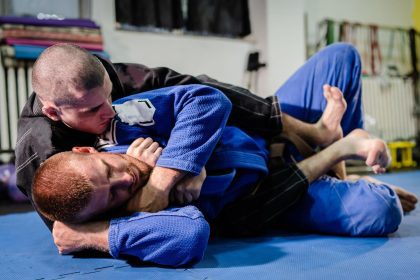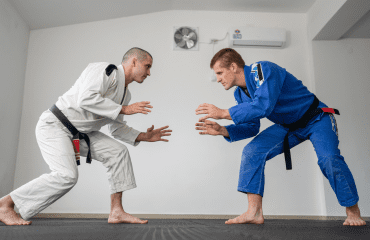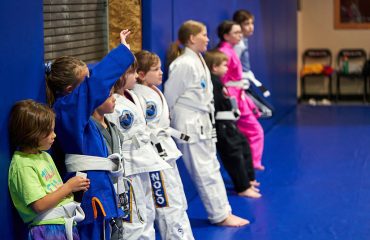
In the world of martial arts, the efficiency and artistry of Jiu-Jitsu stand out, particularly in its use of chokes. At NOCO Jiu-Jitsu and Self-Defense, our focus is on the strategic and safe application of these techniques. Jiu-Jitsu chokes are not just methods of submission; they represent a deep understanding of leverage, positioning, and human anatomy.
The Essence of Jiu-Jitsu Chokes
Jiu-Jitsu, a martial art with deep roots in Japan and refined in Brazil, is known for its ground fighting techniques and submission holds, especially chokes. These techniques are designed to subdue an opponent, emphasizing skill and technique over brute strength. In our classes at NOCO Jiu-Jitsu and Self-Defense, we teach our students that the art of choking in Jiu-Jitsu is about control, precision, and respect for one’s opponent.
There are essential principles we instill regarding the responsible execution of Jiu-Jitsu chokes. We remind students that sparring partners are teammates first—these techniques should never be applied out of ego, aggression, or malicious intent. When tapping out, the applicant must respect the signal and promptly release pressure. We forbid using strikes or excessive force to dismantle an opponent’s posture or establish choke positions.
Fundamentally, chokes represent a technical challenge between two dedicated craftsmen rather than a tool for harm. Students must tap early once proper leverage and positioning indicate a choke’s inescapability. This builds trust that teammates will conclude the exchange before any damage or harm occurs. Chokes ultimately test the defender’s adaptability and problem-solving skills. By training them extensively in a controlled manner, students can safely sharpen their repertoire for tournaments and self-defense alike.
Types of Chokes
Jiu-Jitsu chokes can be broadly classified into two categories: blood chokes and air chokes. Blood chokes, such as the Rear Naked Choke or the Triangle Choke, compress the carotid arteries, temporarily restricting blood flow to the brain and causing the opponent to lose consciousness if held for an extended period. Air chokes, on the other hand, like the Guillotine Choke, target the windpipe, making it hard for the opponent to breathe.
When executing blood chokes, students must be extremely mindful of grip placement and pressure. Poorly applied chokes can unfortunately damage the trachea or larynx. Our instructors repeatedly demonstrate proper finishing mechanics – cinching elbows together and driving through with the lats and back rather than straining the arms or wrists. We teach modest, steady pressure application rather than brute strength to achieve needed artery compression. Partners must tap immediately once blood flow becomes impeded.
With air chokes, we prohibit using fists, forearms, or uncontrolled motions near the neck to prevent injury. Instead, we show precise leveraging of the crook of the elbow against veins without impacting the fragile windpipe. Regardless of technique, we instill a duty of care towards teammates when applying submissions. Progressing slowly and methodically under coach supervision ensures students remain safe while integrating advanced skills into their games.
Learning the Techniques
Our instruction at NOCO Jiu-Jitsu and Self-Defense starts with establishing core techniques. We ensure students grasp executing chokes properly – hand and leg positioning, mechanics of constriction, and applying targeted pressure. Keeping partners safe stays central, so we train to recognize choke effectiveness and when tapping out prevents harm. Building this foundation proves critical before advancing skills.
We instill a careful, step-by-step process for properly progressing through choke finishes. Coaches first demonstrate the exact grip setups, limb positioning, and body alignments needed to initiate the submission. Students drill these concepts thoroughly in the air and slowly on partners before ever adding speed or pressure. Our curriculum prioritizes reps over resistance early on to ingrain proper mechanics. We repeatedly reinforce key concepts like establishing dominant angles, nullifying opponent leverage, and transitioning between technique chains. Only once the movements become second nature do students incorporate chokes into dynamic sparring scenarios.
Even then, coaches watchfully monitor for safety, providing real-time adjustment and feedback. If we observe poor execution or a lack of control, we immediately have students regroup for remedial drilling. This systematic instruction ensures students integrate choke techniques as safe, effective options alongside joint manipulations and other submissions. With these thorough foundations, students can appreciate chokes as high-level problem-solving challenges rather than dangerous acts of brute strength.
The Strategy Behind Chokes
Effectively executing chokes in Jiu-Jitsu involves more than brute technique – strategy plays a crucial role. Seasoned artists understand opening paths to opponents’ vulnerabilities, waiting for prime moments to initiate constriction. This reflects immense patience, imprinted timing, and a profound grasp of foundational Jiu-Jitsu tenets. Mastering both physical and mental quickens the submission process.
Our curriculums spend significant time on the strategy surrounding submissions—particularly chokes given their fight-ending capabilities. We want students to think multiple movements ahead, like chess players. What grips force reactions that open choke opportunities? How can you bait opponents to expose vulnerabilities? Which combinations draw attention away from choke setups? When is posting an arm ill-advised versus blocking a hip? We teach chaining submissions and transitions together based on opponent reactions rather than seeking one move.
Our classes also explore positional hierarchies and the types of chokes inherent to each. For example, securing a back mount or mount makes rear naked or cross collar chokes the highest percentage. The front headlock creates openings for anacondas or darces while the north-south spurs north-south chokes. We ensure students know the highest yield chokes from every position and how to methodically move between them while nullifying opponents’ games. With these strategic foundations, finding and exploiting brief choke windows becomes intuitive through experience. Rather than flailing limbs and strength, seasoned practitioners use timing, misdirection, and positional awareness to draw opponents into inescapable chokeholds.
Training at NOCO Jiu-Jitsu and Self-Defense
NOCO Jiu-Jitsu and Self-Defense adopt a broad-based training ethos – we construct durable foundations encompassing strength, flexibility, and stamina alongside technique. Our diverse curriculum explores numerous dimensions from standing strikes to ground exchanges, imparting appreciation for Jiu-Jitsu’s extensive breadth. This well-roundedness breeds capability exceeding isolated skill.
We optimize students’ development through periodization and varied training modalities. Classes intermix technique drilling, live transitions, situational sparring, and hard rounds fitting to each belt level. We also host open mats for less structured refinement through higher-intensity rolls. Skill work focuses on proper movement patterns and biomechanics to foster durability and longevity. We layer in strength training to tailor physicality for grappling demands. Mobility work maintains healthy joints and flexibility for the guard play and submissions integral to Jiu-Jitsu.
The blending of these training aspects allows students to sharpen skills while also enhancing attributes to utilize those techniques. Compared to other gyms, our diverse offering of classes forges more well-rounded grapplers. Students gain real mat time against an array of styles, body types, and experience levels. This builds the adaptability needed to apply their games against anyone. With these comprehensive foundations, NOCO students gain sharp technique and cagey strategy reinforced by tailored physicality for peak performance.
Safety First
In learning Jiu-Jitsu chokes, safety is our utmost priority. We create a controlled environment where students can practice without fear of injury. Our instructors are experienced and attentive, ensuring that each student learns at a pace suitable for them.
We take great care to minimize risks when students explore such an advanced skill. Instructors constantly monitor student drilling, scrutinizing forms and providing individual adjustments. When trying a choke for the first time, students apply gradual pressure under guidance so partners understand proper tape timing. Until the finishing mechanics become instinctual, we mandate drilling at reduced speeds with no resistance. This engrains fluidity and control first before timing against the dynamic defense. Coaches also deliberately match students by size, strength, and experience levels to prevent physical mismatches.
While exploring choke defense, instructors prohibit overly muscling techniques so defenders learn technical solutions rather than using athletic attributes. If we witness poor execution or insufficient control at any time, students are pulled aside for remediation before continuing. By fostering an environment focused on safety and personal improvement over performance, students absorb techniques at an individualized pace. Our system prioritizes reps over resistance until core concepts are cemented. With these precautions, students gain confidence in applying submissions at intensity knowing risks are minimized.
Community and Respect
Jiu-Jitsu goes beyond being just a martial art; it represents a community. At NOCO Jiu-Jitsu and Self-Defense, we cultivate an environment of mutual respect, friendship, and ongoing education. We hold the view that each person’s path in Jiu-Jitsu is distinct and tailored to their own experiences.
Our gym prides itself on cultivating an environment focused on growth rather than purely performance. Students support teammates as enthusiastically as their training. We emphasize that while chokes showcase your skills, tapping early when caught keeps partners safe to train another day. You must approach sparring as a collaborative effort to refine technique. Our family-like culture allows students to forge tight bonds by sharing the wins and losses from this adventure together. We celebrate each person’s strengths while working to uplift weaknesses through teamwork. No matter someone’s size, athleticism, or current ability, they will find positive reinforcement rather than judgment. Each class ends with fist bumps for everyone from nail-biting newcomers to seasoned competitors. We ultimately measure success by the passion students show and the allies they inspire. Our special community expands beyond just training partners to friends who visit soccer games, weddings, and hospitals together. Under the guiding principle of “leave your ego at the door,” NOCO Jiu-Jitsu and Self-Defense breed excellence through an encouraging, tight-knit tribe.
The Benefits of Learning Jiu-Jitsu Chokes
Studying Jiu-Jitsu choke techniques provides multiple advantages. It boosts physical health, strengthens mental resilience, and hones self-defense capabilities. Additionally, it instills discipline, fosters respect, and underscores the significance of tactical thinking.
While dangerous without honing, Jiu-Jitsu chokes deliver far-reaching personal development attributes with proper guidance. Physically, defending and applying chokes builds core strength, grip endurance, and cardiovascular fitness critical for grappling. The patience required to set up submissions develops mental endurance akin to chess matches. Learning to stay relaxed when neck pressure mounts teaches stress management applicable to everyday life. Chokes also create leverage equalizers to neutralize larger attackers making women and children feel safer. The care needed to prevent injuries fosters empathy and emotional intelligence as well. When performed correctly, chokes represent calculative feats requiring listening to partners’ safety signals.
Ultimately, Jiu-Jitsu’s dependence on technique over strength imparts students of all ages and body types with survivability and confidence. But the greatest benefit lives in the bonds built through communal struggle. Our gym becomes a sacred ground where people encourage each other to conquer perceived limitations. We grow together – sometimes literally shoulder-to-shoulder in side control. The self-realization that happens to sweat and grinding in shared adversity is impossible to quantify. At NOCO Jiu-Jitsu and Self-Defense, we empower the best versions of ourselves through the forge of well-intentioned chokeholds.
Physical and Mental Fitness
Practicing Jiu-Jitsu chokes requires and builds physical strength, flexibility, and cardiovascular health. Mentally, it challenges practitioners to think critically, remain calm under pressure, and maintain focus.
Our curriculum develops the vital physical attributes for Jiu-Jitsu through situational drilling and hard, technical sparring. Holding positions for wrenching choke setups requires a lot from the core and grip strength needed in grappling exchanges. Finishing chokes against intense resistance builds latency in the lats, delts, and arms as well. Frequent positional battles also flex the hips and spine through granular movements rarely activated day-to-day. This functional range of motion keeps joints healthy for the constant kinetic movements inherent to the sport. In terms of cardio, the constant urgency to advance positions or defend choke attempts sustains elevated heart rates through rounds.
Our training replicates the energy system demands of competitions and self-defense alike. Beyond conditioning, our training forges mental toughness even more dramatically. The split-second decisions of roll timing challenge instinct, pattern recognition, and emotional regulation under dire circumstances. Students regularly confront feelings of panic, frustration, and perceived limitations. But our methodology breeds resilience rather than defeat in those moments. We teach fighting the hands first before conceding a finish and tapping early once caught so students retain psychological safety to try again. This atmosphere makes classes exciting crucibles to discover how we respond under fire rather than regarding mistakes as failures. Ultimately our training unveils students’ leadership potential by compelling them to be at their best when it matters most.
Self-Defense Skills
Understanding and mastering Jiu-Jitsu chokes equips individuals with effective self-defense techniques. These skills are practical and can be life-saving in dangerous situations.
While general martial arts training boosts self-protection capabilities enormously, Jiu-Jitsu’s emphasis on submissions—especially chokes—makes it uniquely valuable for self-preservation. Our curriculum prioritizes high-percentage techniques proven to control larger, stronger attackers when striking may be ineffective or dangerous. Chokes provide humane ways to neutralize threats rather than relying on strikes that can permanently injure or kill. Unlike joint locks, chokes allow smaller defenders to finish encounters quickly without pain compliance that depends on attackers’ rational reactions.
Our training also considers real-world variables like curbs, stairs, slick terrain, and uneven footing during takedowns. We want muscle memory prepared for takedowns adaptable to the environment when emergencies dictate. Our self-defense philosophy enables victims to remain opposite threats as engagements go to the ground through guard retention and guard recovery techniques. Here chokes present lower-risk finishes from the bottom against dominant positions compared to isolated limb attacks. By combining positional grappling with finishing holds, our self-defense system gives citizens reliable tools to gain safety in society’s increasingly unstable climate.
Building Confidence and Discipline
The process of learning and mastering Jiu-Jitsu chokes builds confidence. It instills a sense of achievement and discipline, as practitioners set goals and work steadily towards achieving them.
Progressing through our choke curriculum develops confidence through a series of small wins. Tapping a resistant partner for the first time with a blood choke brings immense gratification. Hitting a standing rear naked choke takedown in live training proves your hours drilling the technique against nonexistent opponents translate. Even subtle victories like improved grip fights or more relaxed finishing mechanics bolster self-assurance. Compounding these micro-achievements constructs the resilience to overcome inevitable setbacks. You may still get caught in a choke yourself, but framing or hand fighting a little longer before tapping may become a personal victory.
Our path focuses attention on winning the battles within ourselves rather than just besting training partners. Demonstrating personal growth in the micro gives students the confidence to believe in their long-term development. Beyond skill building, seeing progress from showing up daily and pushing through fatigue inspires discipline. As chokes get tighter, discomfort mounts. But tapping is a mental concession while gritting through the finish line sparks growth. That willingness to be uncomfortable trains determination translatable to life’s bigger challenges outside Jiu-Jitsu. Through tribulations and triumphs alike, students realize confidence and discipline intertwine on the path to mastery.
Discovering the art of Jiu-Jitsu chokes at NOCO Jiu-Jitsu and Self-Defense is an experience that extends well beyond the training mats. It involves character development, nurturing a sense of community, and absorbing the deep teachings of Jiu-Jitsu. For both novices and seasoned practitioners, the ever-evolving domain of Jiu-Jitsu chokes offers endless opportunities for learning and growth.




